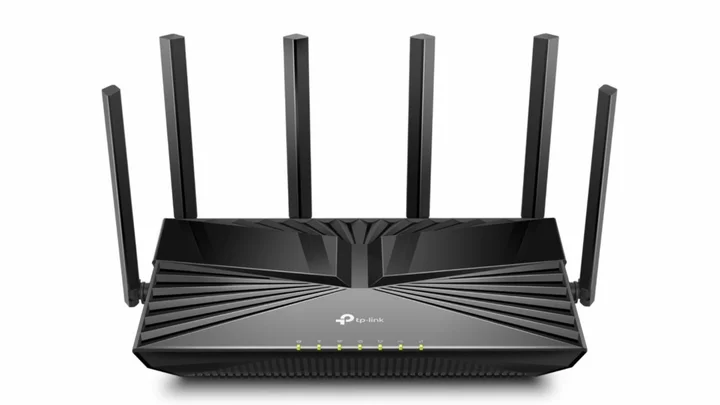Designed for midsized houses and moderate budgets, the TP-Link Archer AX5400 Pro ($199.99) is a dual-band Wi-Fi 6 router that offers a handful of welcome features, including multi-gig WAN/LAN connectivity, free HomeShield software, and mesh capabilities. The router performed admirably in our throughput and signal-strength tests, but its file-transfer scores were just average. The Archer is a solid value among mainstream routers, but our Editors' Choice award winner the Synology WRX560 offers many of the same features and better overall performance for just a few dollars more.
Design and Features: Six Poles for Wi-Fi 6
The AX5400 Pro follows the same basic design as most other TP-Link Archer routers. The top contains grillwork separated by two glossy black panels, holding seven LED activity indicators for power, both radio bands, internet, Ethernet, USB, and WPS. It's fenced on three sides by six adjustable, nonremovable antennas. Around back, you'll find three 1Gbps LAN ports, a 1Gbps WAN/LAN port, and a 2.5Gbps WAN/LAN port. These are joined by LED, Wi-Fi, WPS, reset, and power buttons and a USB 3.0 Type-A port on the right side of the enclosure.
(Credit: TP-Link)Under the hood are a 1GHz dual-core CPU and 512MB of RAM. As a dual-band router, the TP-Link can reach data rates of up to 574Mbps on the 2.4GHz radio band and up to 4,804Mbps on the 5GHz band. It's a Wi-Fi 6, not 6E, router so it doesn't support 6GHz transmissions, but it offers all the latest Wi-Fi 6 (802.11ax) technologies, including 4X4 MU-MIMO simultaneous data streaming, 1024 QAM, 160MHz channel bandwidth, direct-to-client beamforming, OFDMA (orthogonal frequency-division multiple access) transmissions, and WPA3 encryption. The device also supports TP-Link's OneMesh tech, meaning you can use it as a component in a whole-home mesh Wi-Fi network.
(Credit: TP-Link)The AX5400 Pro can be managed via the web console or TP-Link's Tether mobile app. The console opens to a Network Map screen that shows internet status, the router, the number of connected mesh devices, and the number of connected client devices. Tap the router to see LAN IP and MAC information; wireless and guest network SSID, password, and channel information; and CPU and memory usage reports. Tap the client-devices icon to see which clients are currently connected, how long they've been connected, and real-time data rates. Here you can set bandwidth limits and block each device.
(Credit: TP-Link)At the top of the dashboard screen are buttons marked Internet, Wireless, HomeShield, and Advanced. Use the first to select your WAN port (2.5Gbps or 1Gbps) and configure your internet connection and MAC clone settings. The Wireless button opens a screen where you can enable or disable settings such as OFDMA, target wake time, and Smart Connect (one SSID for both bands). Here you can also change SSID names and passwords and configure guest networking.
Use the Advanced button to configure LAN IP and subnet settings as well as DHCP server settings. Other Advanced options include VPN client and server settings, NAT forwarding, OneMesh setup, and firewall settings.
(Credit: TP-Link)Despite the HomeShield button in the console, you'll need to download the TP-Link Tether mobile app to access and manage the HomeShield parental control and network security tools. Here you can create profiles for family members, add devices to each profile, and assign age-oriented filters to prevent access to sites with adult content or gambling, social networking sites, and more.
To set time limits, create time rewards, and view network traffic reports, you must upgrade to HomeShield Pro for $5.99 per month or $54.99 per year. The router comes with basic network security tools that provide security scans and tells you when a new device has joined the network, but you'll need the Pro plan for advanced features such as web protection, intrusion prevention, and IoT protection.
Installation and Performance
Installing the Archer AX5400 Pro was fast and easy. I started by unplugging my modem and connecting the AX5400 Pro to it using the provided LAN cable. I also connected a desktop PC to the router. I powered up the router and modem, waited a few minutes for the former's LED indicators to light up, and opened a browser on my desktop PC.
(Credit: TP-Link)I typed http://tplinkwifi.net in the address bar to open the web console, where I was prompted to create an administrative password and select my time zone. I checked which WAN port I was using, chose Dynamic IP, and used the default MAC address. After disabling Smart Connect, I gave each SSID a name and a shared password and waited a few seconds for the router to perform a connection test, then updated the firmware to complete the installation.
The AX5400 Pro is a solid performer. Its score of 132Mbps in our 2.4GHz close-proximity test was just a few ticks slower than the Synology WRX560's 134Mbps, but beat the Asus ROG Strix GS-AX5400 (128Mbps) and the TP-Link Archer AX3200 (125Mbps). At a distance of 30 feet, the AX5400 Pro delivered 45Mbps, again trailing the Synology (62Mbps) but topping the Asus and the Archer AX3200 (44Mbps each).
Throughput performance on the 5GHz band was also very good. The AX5400 Pro managed 877Mbps in the close-proximity test, topping the ROG Strix (846Mbps) and the TP-Link AX3200 (830Mbps) but trailing the Synology WRX560 (931Mbps). At 30 feet, the router posted a score of 445Mbps, once again besting the Asus (424Mbps) and the Archer AX3200 (399Mbps). The Synology WRX560 led the way at 576Mbps.
To test a router's read and write file-transfer performance, we time how long it takes to move a 1.5GB folder containing photos, video, music, and office document files back and forth between a USB 3.0 external drive and a desktop PC (both connected to the router). Here the AX5400 Pro proved merely average, managing 42MBps in both tests while the Synology WRX560 scored 47MBps (write) and 48MBps (read). The TP-Link Archer AX3200 scored 51MBps (write) and 54MBps (read), while the Asus GS-AX5400 took top honors with scores of 69MBps and 85MBps in the write and read tests respectively.
We test Wi-Fi signal strength with an Ekahau Sidekick Wi-Fi diagnostic device and the company's Survey mobile app, generating heat maps that show 2.4GHz and 5GHz signal strength throughout our test home. (Note: Ekahau is owned by PCMag's parent company Ziff Davis.)
Ekahau 2.4GHz coverage map for TP-Link Archer AX5400 Pro (Credit: Ekahau) Ekahau 5GHz coverage map for TP-Link Archer AX5400 Pro (Credit: Ekahau)The colors on the maps represent signal strength: dark green indicates the strongest signal, yellow is weaker, and gray indicates very weak or no detectable coverage. The circle on the map represents the router's location. As shown in both maps, the AX5400 Pro had no trouble delivering strong Wi-Fi throughout the house. Signal strength for both bands was a little weaker in the garage area, but this is to be expected given the distance from the router and the walls between the two points.
Verdict: A Capable, Affordable Way to 6
If you're looking to bring Wi-Fi 6 networking to your three- or four-bedroom home, the TP-Link Archer AX5400 Pro is certainly worth a look. At $199.99 it's reasonably priced, and with its easy installation process you'll be up and running in minutes. Its file-transfer performance could use a boost but its throughput and signal strength are first-rate, and it comes with free (well, partly free) parental control and network security software and a multi-gig WAN/LAN port. Unfortunately for the Archer, you'll get all of this plus better all-around performance from the Synology WRX560, so that product remains our top pick for mainstream routers.









